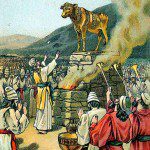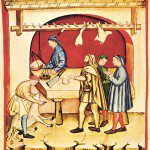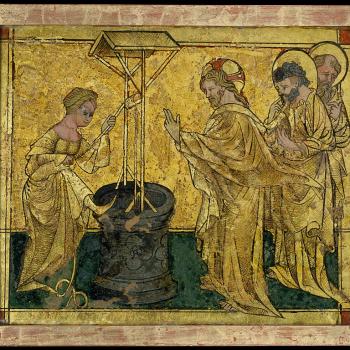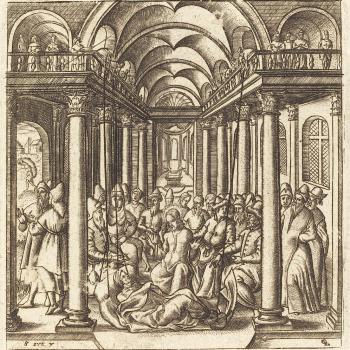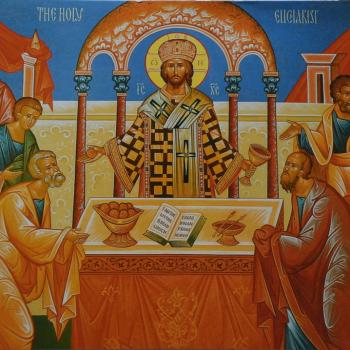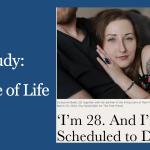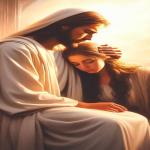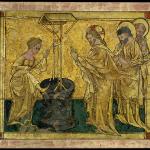![St Mary of Egypt by Anonymous (Icons of Saints at the Orthodox Christian Page.) [Public domain], via Wikimedia Commons](https://wp-media.patheos.com/blogs/sites/637/2016/03/Mary_of_Egypt-254x300.gif)
The Theotokos came to Mary as a mother, as one who wanted to help her wayward children, and so she came with her grace, grace that allowed Mary of Egypt to reconfigure her life. Mary made a promise that she would change her way, stop the cycle of abuse, and turn to God for healing. With her heart turned towards God, she found grace freed her from the structures of sin which had long caught her and abused her. Society had trapped her, forcing her into the role of prostitute, but God’s grace let her out of the structures of sin which had long held her down, so that, with great love, she was able to enter the Holy Sepulchre healed from the damage of her past.
Mary’s glory is certainly one which came out of her heartfelt penitence, but it shows that such penitence must be done for the sake of spiritual healing. She had once accepted the structure of sin found in the society of her day, and let it trample her down, but then she saw through the web of sin, saw that power of grace to help her overcome the systematic structure of sin in society, and so she was able to live in the wilderness, away from society, for years being embraced by the glory of God. She was able to become great in the kingdom of God despite what those who thought themselves great tried to do with her.
Through the life of St. Mary of Egypt, who we remember on the Fifth Sunday of the Great fast, we are able to see the nihilistic power of sin, how it directs us to self-abuse when we accept the power and authority of sham piety to take control of us and our lives. But we are shown that sin does not have to have the last word. Those who enforce the structures of sin in society do not have to define us. Grace allows us to overcome the pretentious and their attempt to destroy us as vessels of their abuse. We can overturn the structures of sin and show ourselves to be true holy vessels of grace and love.
The lesson of Mary is that we are not to think highly of ourselves and lord it over others. Rather, we must see how it is those who are humble and love God, even if they have fallen thanks to the structures of sin and given all kinds of scorn for what they have done, can become great leaders of humanity and the Church, as Christ himself indicated to James and John. It is not those who seek greatness of power and authority, but the lowly and humble that Christ elevates with glory:
Having been a sinful woman, / you became through repentance a Bride of Christ. / Having attained angelic life, / you defeated demons with the weapon of the Cross. / Therefore, most glorious Mary, you are a Bride of the Kingdom! (Kontakion of the Sunday of St. Mary of Egypt).
Yes, she sinned. But the scorn given to her was worse than her sin. God’s image was preserved in her, even though it had been forgotten and neglected by her abusers. It was preserved, and in her humility, it was able to be cleansed by the tears of sorrowful joy as she embraced the Theotokos and found herself risen up beyond the mire society made for her:
The image of God was truly preserved in you, mother, / for you took up the Cross and followed Christ. / By so doing, you taught us to disregard the flesh, for it passes away, / but to care instead for the soul, since it is immortal. / Therefore your spirit, holy mother Mary, Rejoices with the angels! (Troparion of the Sunday of St Mary of Egypt).
Mary was more than her past, more than the sin she had once embraced in the flesh; she was a far greater a person,a far holier a woman, than the so-called pious of the world. Thanks to the greatness within her, she was able to move beyond the abuse and flee to the loving arms of Christ. Let us also follow her example; let us see the beauty of God within us, disregard the sins and bondage to sin we have, and truly embrace Christ in humble love, so we can share with her the glory of God in eternity.
Stay in touch! Like A Little Bit of Nothing on Facebook:
A Little Bit of Nothing


